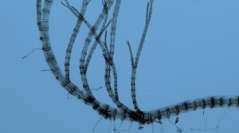

 Cryptogamie, Algologie
42 (7) - Pages 77-91
Cryptogamie, Algologie
42 (7) - Pages 77-91The use of molecular tools in red algal diversity surveys often reveals the existence of undescribed species. Here, we report a new Macaronesian turf-forming red alga in the otherwise mostly Pacific genus Melanothamnus Bornet & Falkenberg. This new taxon, Melanothamnus macaronesicus Rodríguez-Buján & Díaz-Tapia, sp. nov. is described based on morphological and molecular (rbcL gene) evidence. Morphologically, it differs from other Melanothamnus taxa by a combination of characters that includes its decumbent habit with an extensive system of prostrate axes, small size (≤2.5 cm), four ecorticate pericentral cells, unbranched to once-branched trichoblasts and spermatangial branches formed on the first dichotomy of trichoblasts that have a sterile apical cell. Molecularly, this new species differs from its congeners by sequence divergence ≥3.3% in the rbcL gene. Current known distribution of M. macaronesicus Rodríguez-Buján & Díaz-Tapia, sp. nov. is restricted to Macaronesia, suggesting that it could be endemic to this archipelago. Our findings suggest that endemicity among red algae might be more common than previously thought in this bioregion, particularly among easily overlooked turf-forming species.
Algal turfs, endemism, Macaronesia, morphology, overlooked diversity, phylogeny, Polysiphonia, rbcL, Streblocladieae, new species